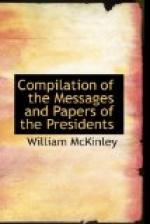The aggregate number of mines placed was 1,535, at the principal harbors from Maine to California. Preparations were also made for the planting of mines at certain other harbors, but owing to the early destruction of the Spanish fleet these mines were not placed.
The Signal Corps was promptly organized, and performed service of the most difficult and important character. Its operations during the war covered the electrical connection of all coast fortifications, the establishment of telephonic and telegraphic facilities for the camps at Manila, Santiago, and in Puerto Rico. There were constructed 300 miles of line at ten great camps, thus facilitating military movements from those points in a manner heretofore unknown in military administration. Field telegraph lines were established and maintained under the enemy’s fire at Manila, and later the Manila-Hongkong cable was reopened.
In Puerto Rico cable communications were opened over a discontinued route, and on land the headquarters of the commanding officer was kept in telegraphic or telephonic communication with the division commanders on four different lines of operations.
There was placed in Cuban waters a completely outfitted cable ship, with war cables and cable gear, suitable both for the destruction of communications belonging to the enemy and the establishment of our own. Two ocean cables were destroyed under the enemy’s batteries at Santiago. The day previous to the landing of General Shafter’s corps, at Caimanera, within 20 miles of the landing place, cable communications were established and a cable station opened giving direct communication with the Government at Washington. This service was invaluable to the Executive in directing the operations of the Army and Navy. With a total force of over 1,300, the loss was by disease in camp and field, officers and men included, only 5.
The national-defense fund of $50,000,000 was expended in large part by the Army and Navy, and the objects for which it was used are fully shown in the reports of the several Secretaries. It was a most timely appropriation, enabling the Government to strengthen its defenses and make preparations greatly needed in case of war.
This fund being inadequate to the requirements of equipment and for the conduct of the war, the patriotism of the Congress provided the means in the war-revenue act of June 13 by authorizing a 3 per cent popular loan not to exceed $400,000,000 and by levying additional imposts and taxes. Of the authorized loan $200,000,000 were offered and promptly taken, the subscriptions so far exceeding the call as to cover it many times over, while, preference being given to the smaller bids, no single allotment exceeded $5,000. This was a most encouraging and significant result, showing the vast resources of the nation and the determination of the people to uphold their country’s honor.
It is not within the province of this message to narrate the history of the extraordinary war that followed the Spanish declaration of April 21, but a brief recital of its more salient features is appropriate.




